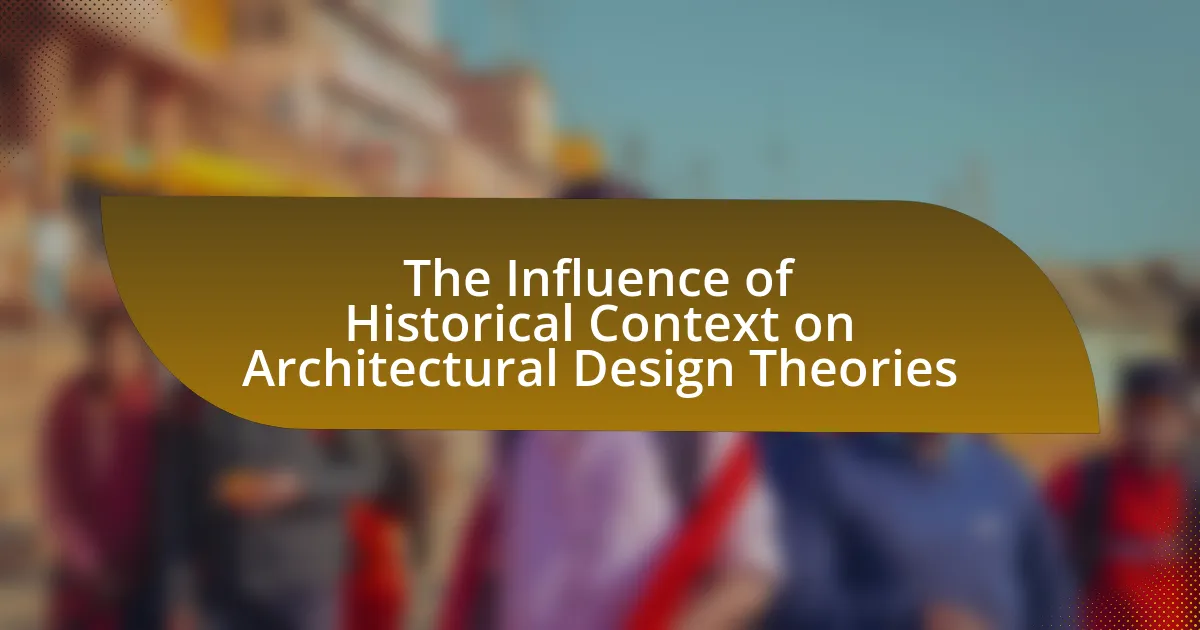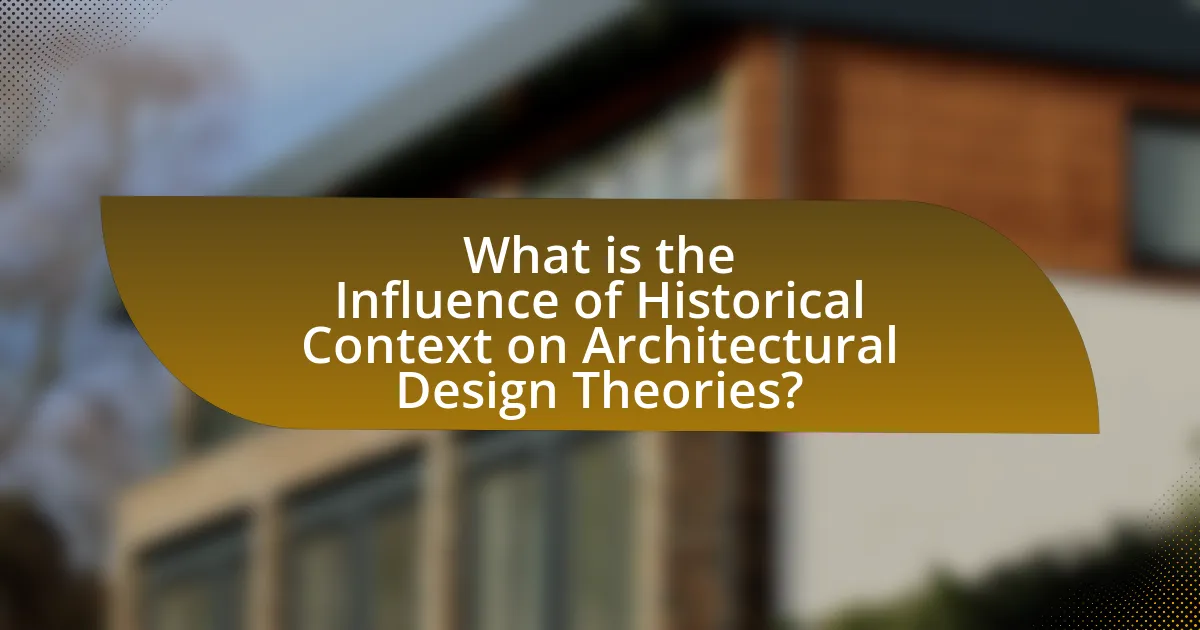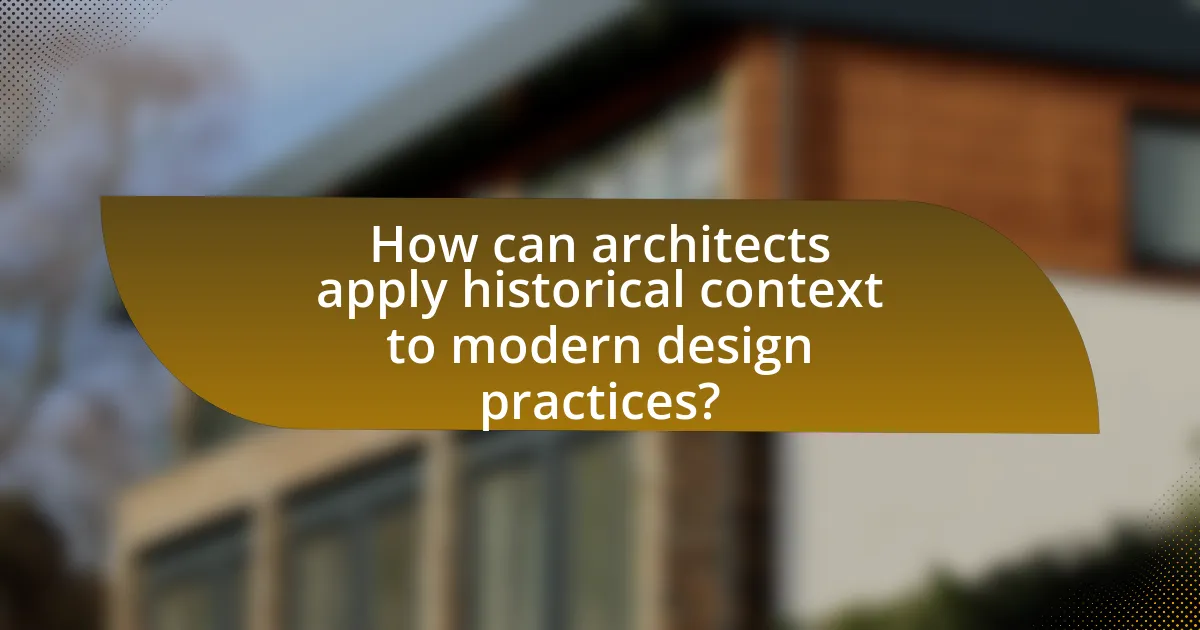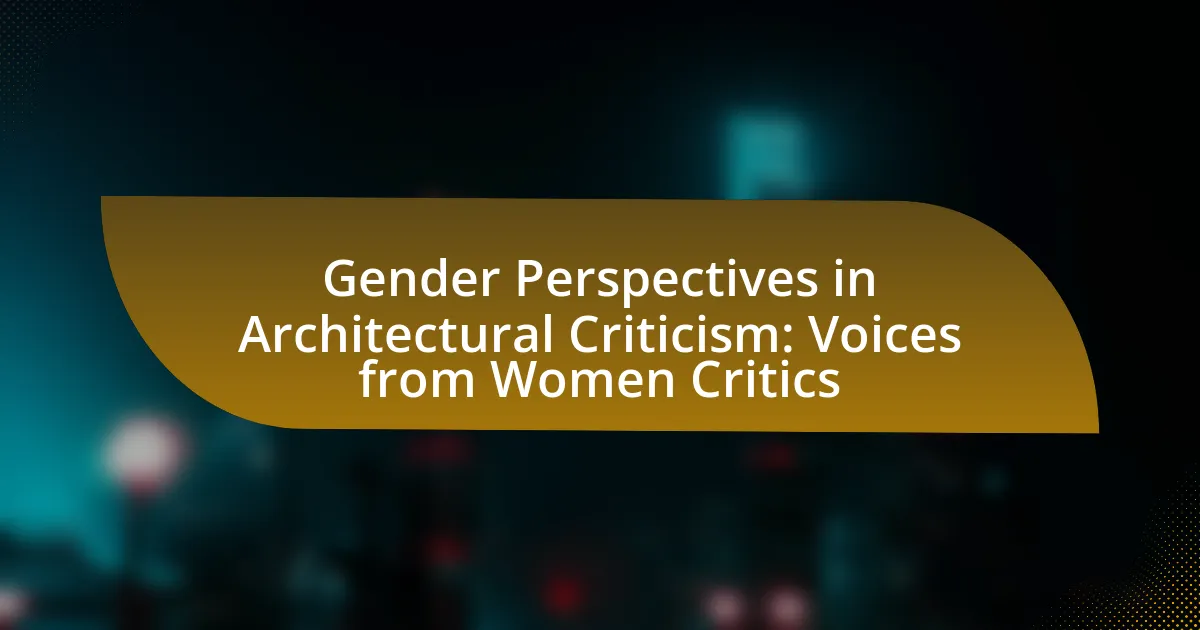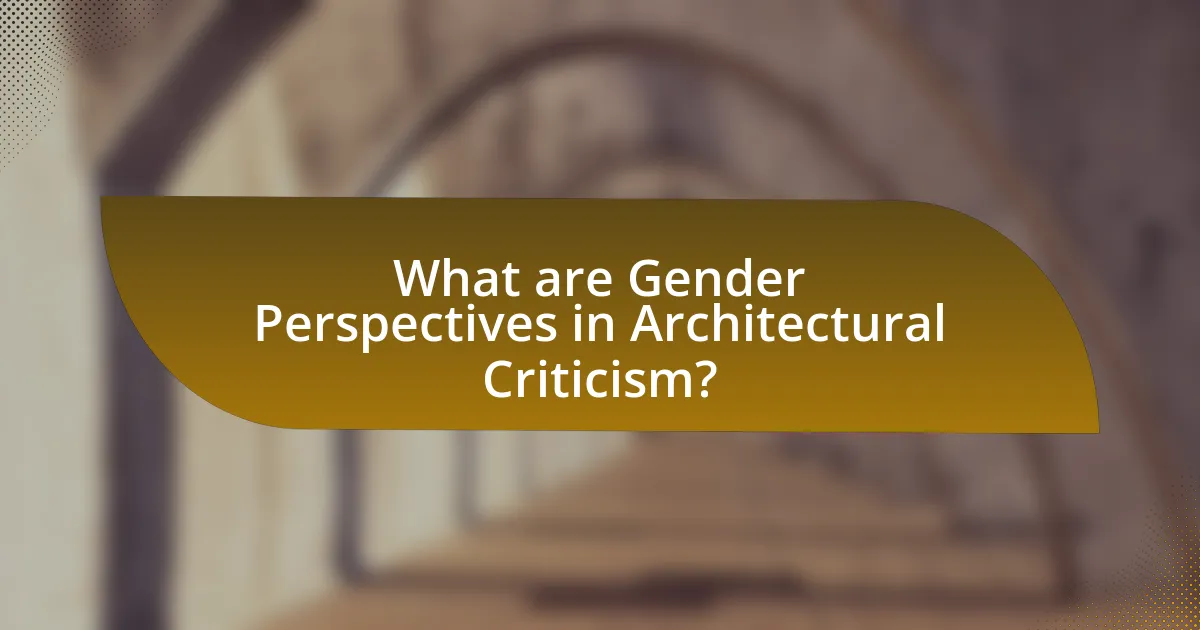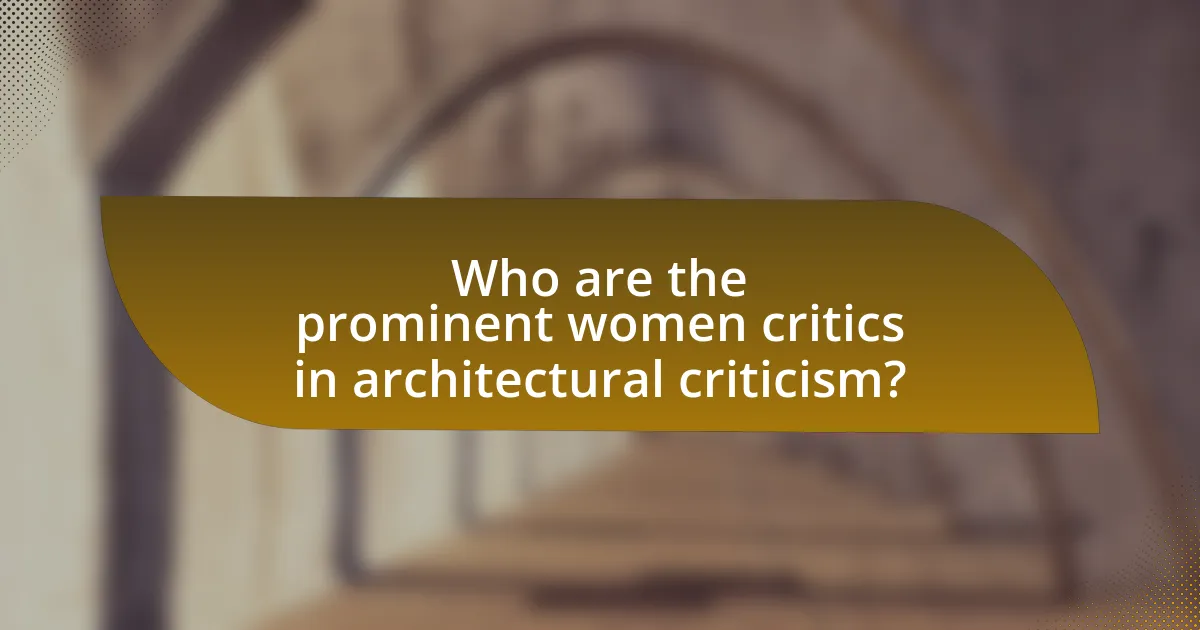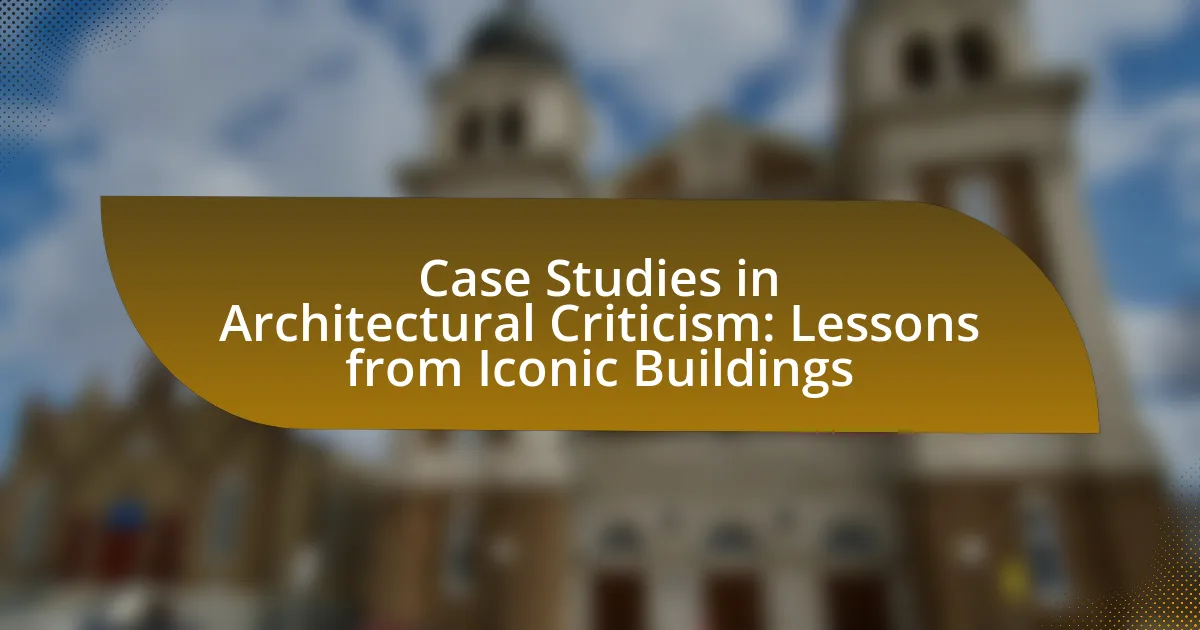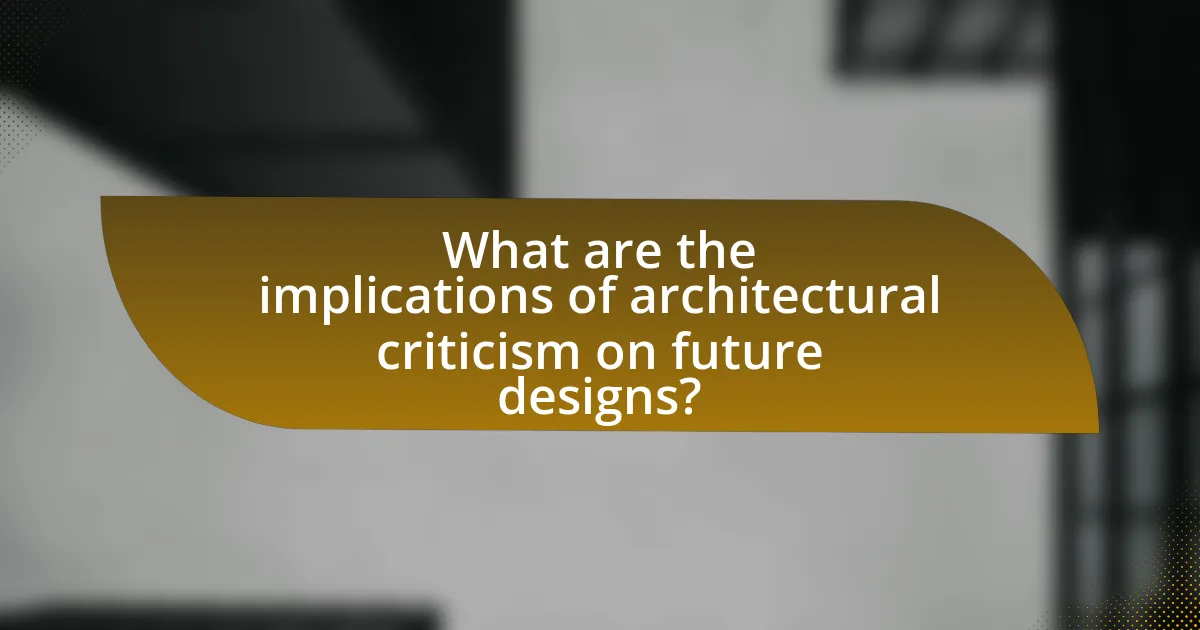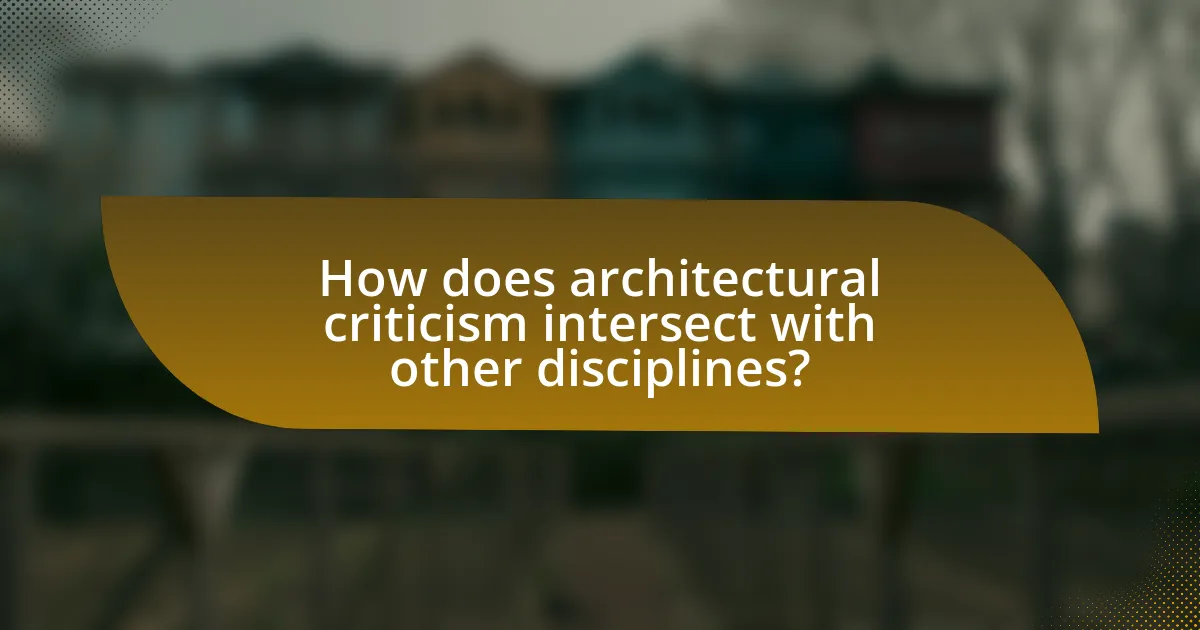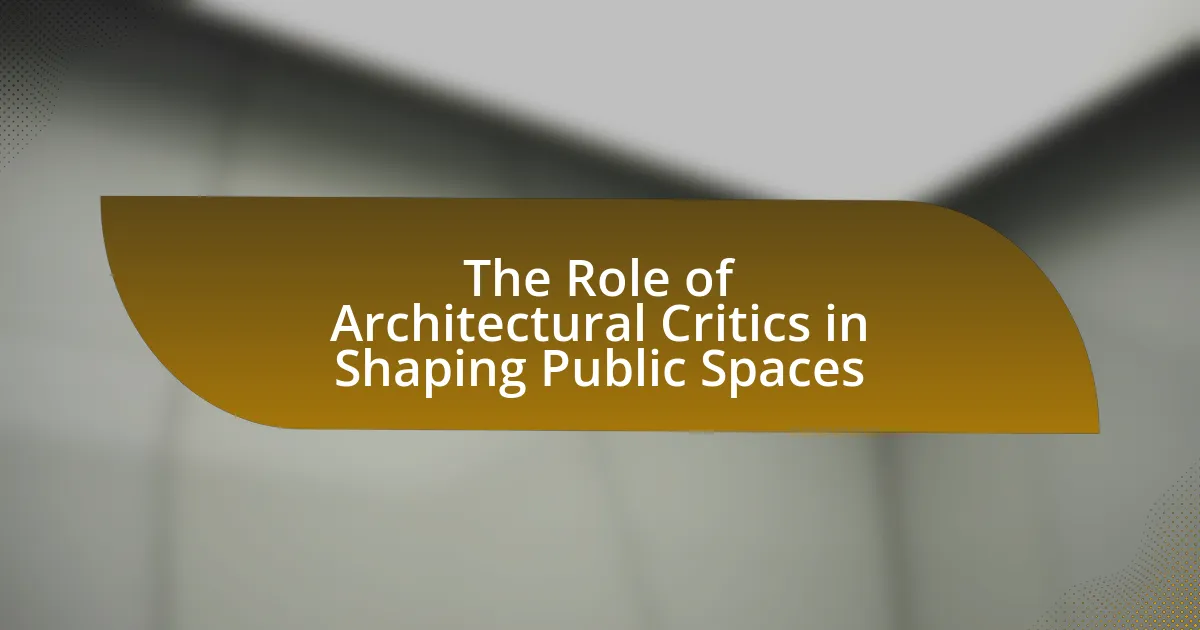The article examines the influence of globalization on architectural design theories, highlighting how cross-cultural exchanges and the integration of diverse styles have led to hybrid architectural forms. It discusses the historical events that have shaped this influence, such as the Industrial Revolution and the rise of digital technology, and explores the impact of cultural exchanges on architectural aesthetics and sustainability practices. Key characteristics of contemporary architectural design, including adaptability, cultural hybridity, and sustainability, are analyzed, along with the challenges architects face in a globalized context. The article also addresses how technology and international collaborations enhance architectural innovation while emphasizing the importance of maintaining local identity amidst global trends.

What is the Influence of Globalization on Architectural Design Theories?
Globalization significantly influences architectural design theories by promoting cross-cultural exchange and the integration of diverse architectural styles. This phenomenon leads to the emergence of hybrid designs that blend local traditions with global trends, as seen in cities like Dubai, where traditional Islamic architecture coexists with modern skyscrapers. Furthermore, globalization facilitates the dissemination of architectural knowledge and practices through international collaborations and digital platforms, allowing architects to adopt innovative materials and sustainable practices from around the world. The result is a more interconnected architectural landscape that reflects both local identities and global influences, reshaping how spaces are conceived and constructed.
How has globalization shaped architectural design theories over time?
Globalization has significantly shaped architectural design theories by promoting cross-cultural exchanges and the integration of diverse styles and technologies. This phenomenon has led to the emergence of hybrid architectural forms that blend local traditions with global influences, as seen in the rise of iconic structures like the Burj Khalifa in Dubai, which combines Islamic architectural elements with modern engineering techniques. Furthermore, globalization has facilitated the dissemination of sustainable design practices, as architects worldwide adopt eco-friendly materials and energy-efficient technologies, influenced by international standards and collaborations. The impact of globalization is evident in the increasing prevalence of international architectural competitions, which encourage innovative designs that reflect a global perspective while addressing local contexts.
What historical events have contributed to this influence?
The historical events that have contributed to the influence of globalization on architectural design theories include the Industrial Revolution, the rise of modernism, and the proliferation of digital technology. The Industrial Revolution, beginning in the late 18th century, transformed construction methods and materials, enabling architects to design larger and more complex structures. The rise of modernism in the early 20th century emphasized functionality and simplicity, reflecting global cultural exchanges and the influence of international styles. Additionally, the advent of digital technology in the late 20th century facilitated global communication and collaboration among architects, leading to the integration of diverse cultural elements into architectural design. These events collectively shaped contemporary architectural practices, making them more interconnected and responsive to global influences.
How do cultural exchanges impact architectural styles?
Cultural exchanges significantly impact architectural styles by facilitating the blending of diverse design elements and techniques. This interaction leads to the emergence of hybrid architectural forms that reflect the influences of multiple cultures. For instance, the Mughal architecture in India showcases a fusion of Persian, Indian, and Islamic styles, evident in structures like the Taj Mahal, which combines intricate ornamentation and symmetrical layouts from these cultures. Additionally, the globalization of architectural practices has resulted in the adoption of sustainable building techniques from various regions, such as the use of bamboo in Asian architecture, which has influenced modern eco-friendly designs worldwide. These examples illustrate how cultural exchanges not only enrich architectural aesthetics but also promote innovation in construction methods and sustainability.
What are the key characteristics of architectural design theories influenced by globalization?
Key characteristics of architectural design theories influenced by globalization include adaptability, cultural hybridity, and sustainability. Adaptability refers to the ability of architectural designs to respond to diverse cultural contexts and technological advancements, allowing for structures that can evolve with changing societal needs. Cultural hybridity manifests in the blending of local architectural styles with global influences, resulting in unique designs that reflect both local identity and international trends. Sustainability emphasizes environmentally responsible practices, integrating green technologies and materials to address global environmental challenges. These characteristics are evident in contemporary architecture, where projects often showcase a fusion of styles and sustainable practices, reflecting the interconnectedness of global cultures and the pressing need for ecological consideration in design.
How do these characteristics differ from traditional architectural theories?
The characteristics influenced by globalization differ from traditional architectural theories primarily in their emphasis on cultural exchange and adaptability. Traditional architectural theories often prioritize local materials, historical context, and established design principles, whereas globalization encourages a fusion of styles and the incorporation of diverse cultural elements. For instance, contemporary architecture frequently integrates sustainable practices and technology, reflecting global trends, unlike traditional approaches that may adhere strictly to regional aesthetics and methods. This shift is evident in the rise of iconic structures that blend various cultural influences, such as the Burj Khalifa in Dubai, which combines Islamic architecture with modern engineering techniques, showcasing how globalization reshapes architectural identity.
What role does technology play in these evolving design theories?
Technology serves as a catalyst in the evolution of design theories by enabling innovative approaches and enhancing creative possibilities. The integration of advanced software tools, such as Building Information Modeling (BIM) and parametric design, allows architects to visualize complex structures and optimize performance, leading to more efficient and sustainable designs. For instance, the use of computational design techniques has transformed traditional architectural practices, facilitating the creation of intricate forms that respond to environmental factors. This shift is evidenced by projects like the Eden Project in the UK, where technology enabled the design of geodesic domes that harmonize with their surroundings. Thus, technology not only influences the aesthetic and functional aspects of architecture but also reshapes the theoretical frameworks guiding contemporary design practices.
What challenges do architects face due to globalization?
Architects face several challenges due to globalization, including increased competition, cultural homogenization, and regulatory complexities. Increased competition arises as architects must now compete with firms from around the world, often leading to a race to the bottom in pricing and quality. Cultural homogenization occurs when local architectural styles and traditions are overshadowed by global trends, resulting in a loss of regional identity in design. Additionally, regulatory complexities emerge as architects navigate varying building codes, zoning laws, and environmental regulations across different countries, complicating project execution and compliance. These challenges highlight the need for architects to adapt their practices to maintain relevance and integrity in a globalized market.
How does globalization affect local architectural identity?
Globalization significantly dilutes local architectural identity by promoting homogenization in design practices. As international styles and materials become prevalent, unique regional characteristics often diminish, leading to a loss of cultural specificity in architecture. For instance, the widespread adoption of glass and steel structures in urban centers worldwide has overshadowed traditional building techniques and local materials, as seen in cities like Dubai and Shanghai, where local architectural styles have been largely replaced by global trends. This trend is supported by studies indicating that cities increasingly resemble one another due to the influence of global architectural firms and the standardization of building codes, which further erodes distinct local identities.
What are the implications for sustainability in architectural design?
Sustainability in architectural design implies a commitment to minimizing environmental impact while maximizing resource efficiency. This approach necessitates the integration of renewable materials, energy-efficient systems, and sustainable site practices, which collectively reduce carbon footprints and promote ecological balance. For instance, the use of passive solar design can significantly lower energy consumption, as evidenced by studies showing that buildings designed with natural light and ventilation can reduce energy use by up to 50%. Furthermore, sustainable architectural practices often lead to improved occupant health and well-being, as buildings that prioritize natural materials and air quality contribute to better indoor environments. Thus, the implications for sustainability in architectural design extend beyond environmental benefits to encompass social and economic dimensions, fostering a holistic approach to building that aligns with global sustainability goals.
How do different regions respond to the influence of globalization in architecture?
Different regions respond to the influence of globalization in architecture through a blend of adaptation and resistance, reflecting local cultural identities and socio-economic contexts. For instance, in urban centers like New York and London, globalization has led to the proliferation of modern skyscrapers and mixed-use developments, showcasing international architectural styles and technologies. Conversely, regions such as rural India or parts of Africa often integrate global architectural trends with traditional building practices, resulting in hybrid designs that respect local materials and cultural heritage. This phenomenon is evidenced by the rise of eco-sensitive architecture in places like Scandinavia, where global sustainability trends are embraced while maintaining regional characteristics.
What are the unique adaptations seen in various cultural contexts?
Unique adaptations in various cultural contexts include the integration of local materials and traditional building techniques into modern architectural designs. For instance, in Japan, architects often incorporate natural elements and minimalist aesthetics, reflecting the cultural value placed on harmony with nature. In contrast, Middle Eastern architecture frequently features intricate geometric patterns and courtyards, which are adaptations to the region’s climate and social customs. These adaptations are validated by the fact that they not only preserve cultural identity but also enhance functionality and sustainability in response to local environmental conditions.
How do economic factors influence architectural responses to globalization?
Economic factors significantly influence architectural responses to globalization by dictating resource allocation, design priorities, and construction methods. For instance, in rapidly developing economies, architects often prioritize cost-effective designs that maximize space and functionality due to budget constraints. This is evident in the rise of modular construction techniques, which allow for quicker and cheaper building processes, as seen in countries like China, where urbanization demands swift housing solutions. Additionally, economic factors such as market demand and investment levels shape architectural styles, leading to the adoption of global design trends that appeal to international investors. For example, the prevalence of glass skyscrapers in financial districts worldwide reflects both the economic aspirations of cities and the influence of global architectural firms.

What are the implications of globalization on contemporary architectural practices?
Globalization significantly influences contemporary architectural practices by promoting cross-cultural exchange and the adoption of diverse design elements. This phenomenon leads to the emergence of hybrid architectural styles that blend local traditions with global trends, as seen in cities like Dubai, where traditional Islamic architecture coexists with modern skyscrapers. Furthermore, globalization facilitates the dissemination of innovative construction technologies and sustainable practices, enabling architects to address environmental challenges more effectively. For instance, the use of prefabricated materials and green building techniques has become widespread due to international collaboration and knowledge sharing. Overall, globalization reshapes architectural identity, encourages sustainability, and fosters a dialogue between local and global contexts.
How do architects integrate global influences into local designs?
Architects integrate global influences into local designs by incorporating diverse cultural elements, materials, and technologies that reflect both international trends and local context. This approach often involves studying global architectural styles and adapting them to meet the specific environmental, social, and cultural needs of the local community. For instance, the use of sustainable building practices, which have gained global traction, can be tailored to local climates and resources, as seen in projects like the Bosco Verticale in Milan, which combines green architecture with urban living. This integration not only enhances aesthetic appeal but also promotes functionality and sustainability, demonstrating how global ideas can be effectively localized.
What strategies do architects use to balance global and local elements?
Architects employ several strategies to balance global and local elements in their designs, including contextual analysis, material selection, and cultural integration. Contextual analysis involves studying the local environment, climate, and cultural heritage to inform design decisions that resonate with the community. Material selection focuses on using locally sourced materials that reflect regional characteristics while also meeting global sustainability standards. Cultural integration ensures that architectural forms and functions respect and incorporate local traditions and practices, creating a dialogue between global influences and local identity. These strategies help architects create buildings that are both relevant on a global scale and meaningful within their specific local contexts.
How does collaboration across borders enhance architectural innovation?
Collaboration across borders enhances architectural innovation by integrating diverse cultural perspectives and technological advancements. This cross-pollination of ideas leads to unique design solutions that reflect a broader range of human experiences and environmental considerations. For instance, the collaboration between architects from different countries can result in the incorporation of sustainable practices from one region with cutting-edge technology from another, as seen in projects like the Bosco Verticale in Milan, which combines vertical gardens with energy-efficient systems. Such partnerships not only foster creativity but also address global challenges, such as climate change, by sharing best practices and innovative materials.
What role do international architectural competitions play in globalization?
International architectural competitions serve as a catalyst for globalization by fostering cross-cultural exchange and collaboration among architects worldwide. These competitions attract diverse participants from various countries, encouraging the sharing of innovative design ideas and practices that transcend local boundaries. For instance, the Venice Biennale, a prominent architectural competition, showcases international talent and promotes dialogue on global architectural trends, thereby influencing local practices and standards. Additionally, winning or participating in such competitions can enhance an architect’s global reputation, leading to international projects and collaborations that further integrate architectural practices across different cultures.
How do these competitions influence design trends worldwide?
Competitions significantly influence design trends worldwide by showcasing innovative ideas and setting benchmarks for creativity and functionality. These events attract global participation, allowing diverse cultural perspectives to converge, which fosters a rich exchange of design philosophies. For instance, the Pritzker Architecture Prize, often referred to as the Nobel Prize of architecture, highlights groundbreaking work that inspires architects globally, leading to the adoption of new materials and sustainable practices. Additionally, competitions like the Venice Biennale serve as platforms for emerging trends, influencing architectural discourse and practice across different regions. This dynamic interaction among participants and the visibility provided by these competitions catalyzes the evolution of design trends on a global scale.
What impact do winning designs have on local architectural practices?
Winning designs significantly influence local architectural practices by setting benchmarks for quality, innovation, and sustainability. These designs often showcase advanced techniques and materials, prompting local architects to adopt similar approaches to remain competitive. For instance, award-winning projects frequently highlight eco-friendly practices, which can lead to a broader acceptance of sustainable architecture within local communities. Additionally, exposure to globally recognized designs can inspire local architects to push creative boundaries, fostering a culture of experimentation and collaboration. This dynamic interaction between winning designs and local practices ultimately enhances the overall architectural landscape, encouraging continuous improvement and adaptation to contemporary trends.
What future trends can be anticipated in architectural design due to globalization?
Future trends in architectural design due to globalization include increased integration of sustainable practices, the adoption of smart technologies, and a focus on cultural exchange in design aesthetics. As global awareness of environmental issues rises, architects are likely to prioritize eco-friendly materials and energy-efficient designs, reflecting a shift towards sustainability in response to climate change. Additionally, the proliferation of smart technologies will lead to the incorporation of automation and data-driven design processes, enhancing functionality and user experience in buildings. Furthermore, globalization fosters cultural exchange, encouraging architects to blend diverse architectural styles and traditions, resulting in innovative and hybrid designs that resonate with a global audience. These trends are supported by the growing emphasis on sustainability in international architectural competitions and the increasing demand for smart buildings in urban development projects worldwide.
How might emerging technologies shape future architectural theories?
Emerging technologies will significantly shape future architectural theories by enabling innovative design processes, enhancing sustainability, and facilitating smart building integration. Technologies such as Building Information Modeling (BIM), artificial intelligence, and 3D printing allow architects to create complex structures with greater efficiency and precision. For instance, BIM enables real-time collaboration among stakeholders, improving project outcomes and reducing costs. Additionally, advancements in materials science, such as self-healing concrete and energy-efficient systems, promote sustainable practices in architecture. The integration of smart technologies, including IoT devices, allows for adaptive building environments that respond to user needs and environmental changes, thereby influencing architectural design principles. These technological advancements are reshaping the architectural landscape, aligning it with contemporary demands for sustainability and functionality.
What potential shifts in cultural perspectives could influence design?
Potential shifts in cultural perspectives that could influence design include the increasing emphasis on sustainability, inclusivity, and local identity. As global awareness of environmental issues rises, designers are adopting eco-friendly materials and practices, reflecting a cultural shift towards sustainability. Additionally, the growing recognition of diverse cultural narratives encourages designers to create spaces that are inclusive and representative of various communities. This shift is evident in architectural projects that prioritize local traditions and materials, fostering a sense of identity and belonging. For instance, the integration of indigenous design principles in contemporary architecture showcases how cultural perspectives can reshape design practices.

How can architects effectively navigate the challenges posed by globalization?
Architects can effectively navigate the challenges posed by globalization by embracing cultural sensitivity and integrating local context into their designs. This approach allows architects to create structures that resonate with the local community while also meeting global standards. For instance, the incorporation of local materials and traditional building techniques can enhance sustainability and cultural relevance, as seen in projects like the National Museum of African American History and Culture in Washington, D.C., which reflects African American heritage while adhering to modern architectural practices. By prioritizing collaboration with local stakeholders and understanding regional regulations, architects can ensure their designs are both innovative and contextually appropriate, thus successfully addressing the complexities introduced by globalization.
What best practices can architects adopt to maintain cultural integrity?
Architects can maintain cultural integrity by engaging with local communities to understand their values and traditions. This practice ensures that designs reflect the cultural context and heritage of the area. For instance, incorporating local materials and architectural styles can enhance the authenticity of a project. Research indicates that projects designed with community input are more likely to be accepted and valued by local populations, as seen in the case of the National Museum of African American History and Culture in Washington, D.C., which integrates African American cultural narratives into its architecture. By prioritizing community engagement and local context, architects can create spaces that honor and preserve cultural identity amidst globalization.
How can architects engage with local communities in their designs?
Architects can engage with local communities in their designs by incorporating participatory design processes that involve community input and feedback. This approach allows architects to understand the specific needs, cultural values, and preferences of the community, leading to designs that are more relevant and accepted. For instance, studies have shown that projects like the Participatory Design Project in Denmark have successfully integrated community voices, resulting in spaces that reflect local identity and foster social cohesion. By actively involving community members through workshops, surveys, and collaborative design sessions, architects can create environments that resonate with the people who use them, ultimately enhancing the overall impact of their work.
What resources are available for architects to learn about global influences?
Architects can access various resources to learn about global influences, including academic journals, online courses, and international conferences. Academic journals such as the Journal of Architecture and the International Journal of Architectural Research publish peer-reviewed articles that explore global architectural trends and theories. Online platforms like Coursera and edX offer courses on global architecture and design, featuring contributions from leading universities. Additionally, attending international conferences, such as the World Architecture Festival, provides architects with insights into diverse architectural practices and networking opportunities with global professionals. These resources collectively enhance architects’ understanding of how globalization shapes architectural design.
What are the key takeaways for architects in a globalized world?
Architects in a globalized world must prioritize cultural sensitivity, sustainability, and technological integration in their designs. Cultural sensitivity ensures that architectural practices respect local traditions and contexts, which is crucial as globalization leads to diverse influences. For instance, the incorporation of local materials and styles can enhance community acceptance and identity. Sustainability is increasingly vital, as architects are called to address climate change through energy-efficient designs and sustainable materials, reflecting a global shift towards environmental responsibility. Technological integration, including the use of advanced software and building information modeling (BIM), allows architects to collaborate across borders and streamline the design process, improving efficiency and innovation. These key takeaways highlight the need for architects to adapt to a rapidly changing global landscape while maintaining a commitment to local relevance and environmental stewardship.
How can architects leverage globalization to enhance their designs?
Architects can leverage globalization to enhance their designs by incorporating diverse cultural influences, materials, and technologies from around the world. This approach allows architects to create innovative and contextually relevant structures that resonate with a global audience. For instance, the use of sustainable materials and construction techniques from different regions can lead to environmentally friendly designs, as seen in the integration of bamboo in architecture, which is prevalent in Asia and recognized for its strength and sustainability. Additionally, exposure to international architectural styles can inspire unique aesthetic choices, as demonstrated by the fusion of modern and traditional elements in projects like the National Museum of African American History and Culture in Washington, D.C., designed by David Adjaye, which reflects both local and global narratives.
What skills are essential for architects to thrive in a global context?
Architects must possess strong cross-cultural communication skills, adaptability, and a deep understanding of global sustainability practices to thrive in a global context. Cross-cultural communication enables architects to effectively collaborate with diverse teams and clients, ensuring that designs resonate with local cultures and values. Adaptability is crucial as architects navigate varying regulations, building practices, and environmental conditions across different countries. Furthermore, a solid grasp of global sustainability practices is essential, as architects increasingly face demands for environmentally responsible designs that meet international standards, such as LEED certification. These skills collectively empower architects to create innovative, contextually relevant designs that address both local and global challenges.

